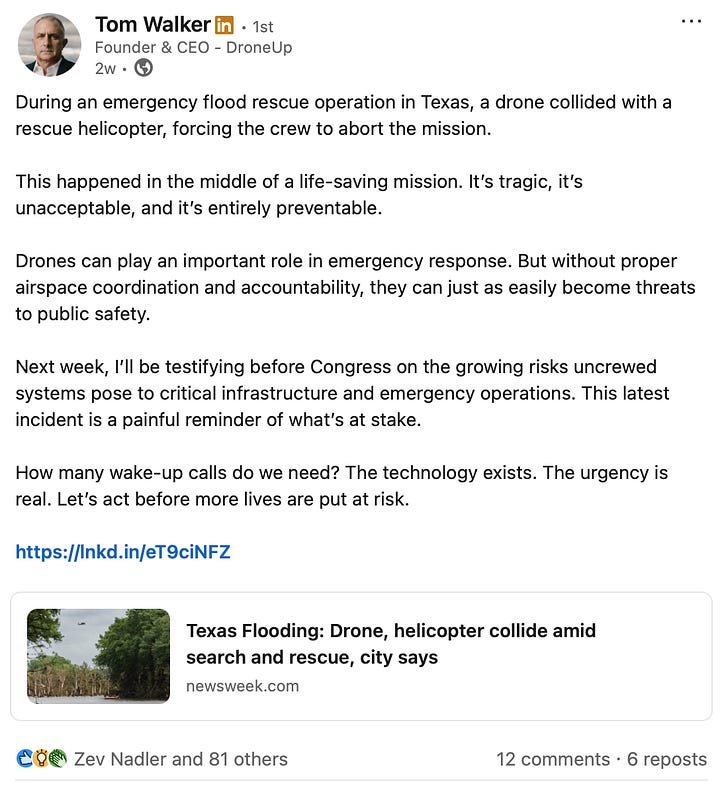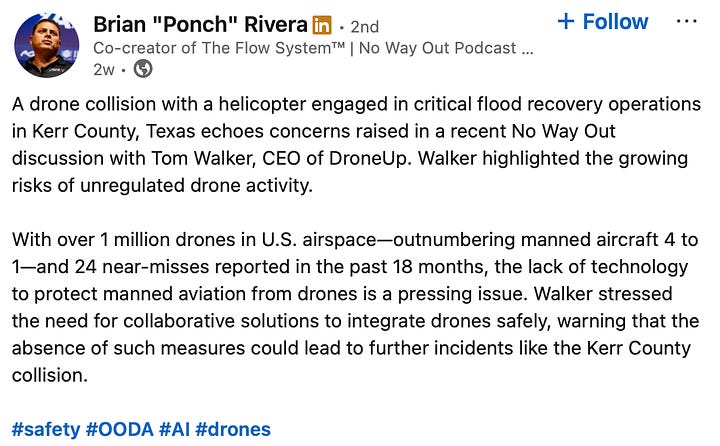Official Narrative Unravels: Sources Say Blackhawk Was Struck by Law Enforcement Drone in Kerrville Flood Response
Officials blamed a rogue drone operator. But sources say it was a law enforcement drone on a routine return flight—raising serious questions about what DPS isn’t saying.
The drone that struck a National Guard Blackhawk helicopter during flood rescue operations in Kerrville, Texas, was not flown by a rogue hobbyist, as officials initially implied. Multiple sources with direct knowledge of the incident tell The Zero Lux the drone belonged to a law enforcement agency and was returning on an automated flight path when it made contact with the helicopter midair.
The incident took place in early July during widespread flooding in Central Texas. Within hours, state and local authorities issued a statement blaming a private drone operator for disrupting emergency efforts and grounding a critical search-and-rescue asset. The narrative spread quickly—picked up by legacy media, and amplified across national and local media. But no pilot was ever named. No damage assessments were released. No debris was recovered publicly. And the record has never been corrected.
Sources say that’s because the official version of events wasn’t true.
A Law Enforcement Drone, Not a Civilian One
Several individuals with credible knowledge of the incident confirm the drone involved was government-operated, flying legally under a Temporary Flight Restriction (TFR), and returning to base on a pre-programmed route. They allege the helicopter, operating at low altitude during search efforts, descended into a zone where drones had been assigned exclusive access at lower altitudes.
“Yes, the drone struck the helicopter,” one source told The Zero Lux. “But it was returning on an automated mission. It wasn’t unauthorized—and it wasn’t civilian.”
A retired police pilot and former National Guard aviator interviewed for this story—who requested anonymity—says he was told early on the drone was mapping or assisting with search operations. He expressed doubt over claims that the tail rotor had been hit.
“If it had struck the tail rotor, you’d have serious damage or worse. More likely, it clipped the tail boom or stabilizer. And from what I heard, they couldn’t even find any damage after landing.”
He also confirmed hearing that airspace coordination had been established before flight operations, with altitude bands assigned to separate manned and unmanned aircraft:
“Initially it was 0–400 for drones, helicopters above 400. But that was later adjusted to 200 and 500 feet. And I heard some of the Guard pilots weren’t respecting the boundaries.”
DPS Dodges Questions, Kerrville Refers Up
When The Zero Lux contacted Kerrville Public Information Officer Stuart Cunyus on July 23, he confirmed the helicopter involved in the incident was an Army National Guard Blackhawk. However, he declined to comment further, stating the matter had been referred to the Texas Department of Public Safety.
“The drone incident was reported to the Texas Department of Public Safety,” Cunyus wrote. “They are conducting the inquiry into this incident. The helicopter was an Army National Guard Black Hawk. I would refer you to the DPS for any statement on their investigation. I do not have a contact to refer you to.”
That same morning, The Zero Lux formally reached out to DPS requesting comment and an interview. The email detailed the scope of the investigation, including reports that the drone was law enforcement-operated and returning on a pre-assigned path.
As of publication, DPS has not responded to multiple follow-up emails or voicemails. No statement, correction, or clarification has been issued by the agency.
The Incident, the Narrative, and the Fallout
The collision occurred on July 7, 2025, and was first announced publicly by the City of Kerrville in a Facebook post later that same day. The post alleged that a “private drone illegally operating in restricted airspace” had collided with a helicopter involved in emergency flood response. It claimed the helicopter was forced to make an emergency landing, and that “a critical piece of response equipment is now out of service until further notice.”
That single sentence—alleging a “private drone illegally operating in restricted airspace”—became the foundation for a media narrative that spread across the country. It assigned both blame and illegality in the same breath, despite offering no evidence. In FAA airspace management, the phrase “restricted airspace” typically refers to permanently designated military zones—not Temporary Flight Restrictions (TFRs), which are routinely issued for disaster areas and coordinated among multiple agencies. The conflation of terms either reflects a fundamental misunderstanding or a deliberate escalation. No public records or investigation findings have been released to support the statement, yet it remains uncorrected.
The statement quickly spread online and shaped the early narrative around the incident. Kerr County Community Services Officer Jonathan Lamb reinforced the city’s version in an interview with KENS 5, stating:
“Flying a drone in restricted airspace can result in a fine of up to $75,000, and you can get your certificate to operate a drone revoked.”
Lamb’s remarks left little room for doubt—publicly affirming that a private drone pilot had interfered in restricted airspace and implying legal consequences would follow. Yet no drone pilot was ever identified. No FAA enforcement action has been disclosed. And no physical evidence has been made public. The narrative was cemented without transparency, and it would go on to shape national policy arguments within days.
Skydio employee John Santry reposted the City of Kerrville’s alert and local media coverage on X, calling the event “entirely preventable.” His tweet received attention across the drone industry, framing the issue as a failure of civilian drone responsibility.
The following day, Adrian Doko—then deployed in Kerrville—posted a warning about unauthorized drone operations, urging users to respect Temporary Flight Restrictions (TFRs). His post was reshared by Michael Robbins, President and CEO of AUVSI, the largest drone industry lobbying group in the United States. A week later, Tom Walker, CEO of DroneUp, cited the Kerrville incident in a LinkedIn post as he prepared to testify before Congress on the risks posed by uncrewed systems to critical infrastructure. He called the incident “tragic,” “entirely preventable,” and “a painful reminder of what’s at stake.”




FAA Safety Team member Scott Shtofman and others amplified the narrative across LinkedIn, reinforcing the impression that the incident was caused by an irresponsible drone pilot violating airspace restrictions during disaster response. Despite a lack of verified facts, the incident rapidly became a rallying cry in the national discussion over drone regulation and federal bans—particularly those targeting DJI.
But multiple credible sources have since confirmed the drone was not operated by a private civilian. It was a law enforcement drone—likely from a Texas-based agency—returning to home on an automated flight path after completing a flood response mission. The aircraft it struck was a Army National Guard Blackhawk helicopter, which may have entered the airspace at an unannounced altitude.
Misinformation Echoes in Washington
On July 17, 2025, during a House Homeland Security Subcommittee hearing on counter-drone threats, Michael Robbins—the President and CEO of AUVSI, the drone industry’s largest lobbying group—invoked the Kerrville helicopter incident while warning lawmakers about changes to DJI’s software safeguards.
“They’ve removed the geofencing,” Robbins said, “so now they can go into a zone like the helicopter incident in Texas that used to not be able until DJI changed their own rules.”
The statement directly referenced the July 7 Blackhawk crash in Kerrville, which was initially blamed on a “rogue drone” in a viral Facebook post by the city. But Robbins didn’t mention that the drone was operated by law enforcement—or that the public narrative was based on incomplete or incorrect assumptions.
Instead, Robbins doubled down on the framing: “All three of these companies, as well as many others, provide a very complex, intimate portrait of the airspace to be able to distinguish between authorized drones and unauthorized rogue drones.”
By repeating the term “rogue drone” in official testimony, Robbins helped solidify a narrative born from a premature public information release—one that industry executives like him and others had quickly amplified online. What was missing from the hearing was any mention that the drone involved in Kerrville was not unauthorized, not civilian, and not operating in defiance of local emergency operations.
The result was a closed loop of misinformation: A rushed public statement triggered industry panic, which then fed into federal testimony that framed American drone operators as hazards rather than public safety partners. All while the root causes—interagency miscommunication, faulty airspace coordination, and unverified blame—went largely unaddressed.
A System Built to Fail
Charles Werner, director of Drone Responders and former fire chief of Charlottesville, Virginia, told The Zero Lux that in most emergencies, communication breakdowns—not technology—are the real threat:
“When a helicopter enters a scene and they don’t announce their arrival, don’t monitor aviation channels, or coordinate with the IC [incident commander], you’re flying into chaos blind. You could have the best deconfliction tools in the world, but they only work if people use them.”
Some have since argued that the drone had FAA authorization to operate at or below 400 feet through coordination with the State Operations Support Center (SOSC) and SGI, the state’s GIS system used during emergencies. If that’s true, its flight path would have been logged—and recorded—making the “rogue drone” claim not just misleading, but provably false through a simple FOIA.
Others point to standard aviation protocol: if a temporary flight restriction (TFR) is in effect, and a Blackhawk is entering without first confirming coordination with other active air assets—including drones—that’s a breach of protocol, not a fluke. Even seasoned SAR pilots with decades of experience note that ADS-B, the broadcast system many use to monitor aircraft in real time, is often missing on both sides: many public safety drones don’t transmit it, and many helicopters—especially military ones—don’t broadcast it either.
This wasn’t a case of a rogue drone disrupting emergency efforts. It was a failure of interagency coordination—where assumptions moved faster than facts, and public statements rushed ahead of verified information. As drones become vital tools in life-saving operations, the need for clear communication and airspace discipline is more urgent than ever.
Records Requests Filed as DPS Remains Silent
Despite multiple calls and emails over a five-day period, the Texas Department of Public Safety has not responded to questions about the Kerrville incident.
In response, The Zero Lux has prepared notarized records requests. A formal submission under the Texas Public Information Act will be delivered to DPS. Additional federal FOIA requests are being sent to the FAA, the National Transportation Safety Board, and the Texas Military Department in relation to Army National Guard coordination.
The filings seek communications, incident reports, flight logs, and any documentation of the drone collision during flood response operations. These certified submissions will be filed in the coming days.
If You Were There, We Want to Hear From You
Temporary Flight Restrictions (TFRs) were active at the time of the incident, and the drone was operating legally within them. Multiple sources with direct knowledge confirm the drone was a law enforcement-operated system on an automated return-to-home flight.
Neither the Texas Department of Public Safety nor the City of Kerrville have issued a correction or disclosed the drone’s origin. No public documentation has been released to support the original narrative—that a civilian pilot violated airspace and collided with a Blackhawk helicopter.
That version of events was rapidly politicized, shared widely on social media by industry figures, and remains uncorrected by any involved agency.
If you have firsthand knowledge or official documentation regarding the incident, contact The Zero Lux at contact@thezerolux.com.






